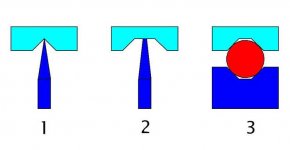Triggered by the recent threads on unipivot-arms I have been thinking about the actual pivot point.
In principle it looks like nr.1 in the drawing below: a cup resting on a perfectly sharp pin. But I assume that in practice it looks more like nr.2: both pin and cup wil not be perfect.
This makes me wonder if something like nr.3 using one ball might be a better solution?
Am I right in my assumptions?
Has this been done before?
Does it/should it work?
Please comment.
In principle it looks like nr.1 in the drawing below: a cup resting on a perfectly sharp pin. But I assume that in practice it looks more like nr.2: both pin and cup wil not be perfect.
This makes me wonder if something like nr.3 using one ball might be a better solution?
Am I right in my assumptions?
Has this been done before?
Does it/should it work?
Please comment.
Attachments
As to your sketch #3,--
one ball resting atop of 3 balls i a lower cup has been suggested in another thread, last year sometime....
Sapphire and ruby balls are rather cheap at Smallparts Inc., I beleive.???
one ball resting atop of 3 balls i a lower cup has been suggested in another thread, last year sometime....
Sapphire and ruby balls are rather cheap at Smallparts Inc., I beleive.???
4 Ball Pyramid
Yup, the 4 ball pyramid (always self centering, no chatter, low wear and still low friction) is used by Wilson Benesch in their unipivots and it was the approach i used fro the pivot of my own DIY.
I got 4 ruby/sapphire ball bearings 1/8 of an inch in diameter, mounted one on a brass thrust plate to bolt to the arm housing and 3 in a cup machined into the top of the arm pillar.
Bearing housing and arm are shaped from rosewood, arm tube is a 1/8 square brass tube set into the side of the arm wand, counterweight and stub are brass as is the thrust plate, arm pillar and base. Headshell is aero grade high tensile aluminium.
As yet I have not wired it up, fitted side weights or antiskate.
I'll try to get some photos for you soon.
Drew
Yup, the 4 ball pyramid (always self centering, no chatter, low wear and still low friction) is used by Wilson Benesch in their unipivots and it was the approach i used fro the pivot of my own DIY.
I got 4 ruby/sapphire ball bearings 1/8 of an inch in diameter, mounted one on a brass thrust plate to bolt to the arm housing and 3 in a cup machined into the top of the arm pillar.
Bearing housing and arm are shaped from rosewood, arm tube is a 1/8 square brass tube set into the side of the arm wand, counterweight and stub are brass as is the thrust plate, arm pillar and base. Headshell is aero grade high tensile aluminium.
As yet I have not wired it up, fitted side weights or antiskate.
I'll try to get some photos for you soon.
Drew
Cheap source of precision bearings.
Ball point pen tips are high precision, small bearings. Consider, the fit of the ball in the socket is so precise that a metered quantity of ink flows through the gap.
Ball point pen tips are high precision, small bearings. Consider, the fit of the ball in the socket is so precise that a metered quantity of ink flows through the gap.
Re: 4 Ball Pyramid
...any photo, yet? 🙂
Stefano
DrewP said:Yup, the 4 ball pyramid (always self centering, no chatter, low wear and still low friction) is used by Wilson Benesch in their unipivots and it was the approach i used fro the pivot of my own DIY.
I got 4 ruby/sapphire ball bearings 1/8 of an inch in diameter, mounted one on a brass thrust plate to bolt to the arm housing and 3 in a cup machined into the top of the arm pillar.
Bearing housing and arm are shaped from rosewood, arm tube is a 1/8 square brass tube set into the side of the arm wand, counterweight and stub are brass as is the thrust plate, arm pillar and base. Headshell is aero grade high tensile aluminium.
As yet I have not wired it up, fitted side weights or antiskate.
I'll try to get some photos for you soon.
Drew
...any photo, yet? 🙂
Stefano
peterr said:Triggered by the recent threads on unipivot-arms I have been thinking about the actual pivot point.
In principle it looks like nr.1 in the drawing below: a cup resting on a perfectly sharp pin. But I assume that in practice it looks more like nr.2: both pin and cup wil not be perfect.
This makes me wonder if something like nr.3 using one ball might be a better solution?
Am I right in my assumptions?
Has this been done before?
Does it/should it work?
Please comment.
It does not matter which of the application you apply as long as the contact point is precisely matched. Which mean it must cross the Hi-Fi News track(side 1 band 8) without distortion
- Status
- Not open for further replies.
- Home
- Source & Line
- Analogue Source
- Unipivot principle
